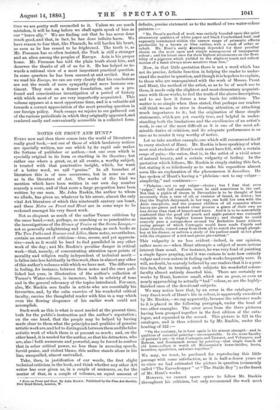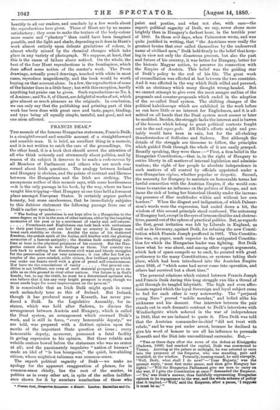NOTES ON PROUT AND HUNT.* EVERY now and then there
comes into the world of literature a really good book,—not one of those of which laudatory notices are specially written, nor one which by its rapid sale makes the fortune of publisher or author,—not one even which is specially original in its form or startling in its theories ; but rather one where a great, or, at all events, a worthy subject, is treated with that penetrative insight, which, for want of a better word, we call "genius." In all branches of literature this is of rare occurrence, but in none so rare as in the literature of Art. The works of the kind we mention which have been written in our own day number scarcely a score, and of that score a large proportion have been written by one man. Mr. John Ruskin, the author to whom we allude, has given us, whatever be his errors, almost the only vital Art literature of which this nineteenth century can boast, and these Notes on Prone and Hunt are in some ways to be reckoned amongst his very finest work.
Not so eloquent as much of the earlier Turner criticism by the same hand,—not, perhaps, so searching or so penetrative as the investigations of the Stones of Venice or the Seven Lamps,— not so generally enlightening and awakening, as such books as The Two Paths and Sesame and Lilies, these notes, nevertheless, contain an amount of criticism—tree, severe, and yet apprecia- tive—such as it would be hard to find paralleled in any other work of the day ; and Mr. Ruskin's peculiar danger in critical work—that, namely, of concentrating attention upon points of morality and religion really independent of technical merit— is fallen into less habitually in this work, than in almost any other of this author's volumes with which we have met. The difference in feeling, for instance, between these notes and the ones pub- lished last year, in illustration of the author's collection of Turner's Water-colours, is immense, both in sobriety of tone and in the general relevancy of the topics introduced. For once, also, Mr. Ruskin sees faults in artists who are essentially his favourites, and, by the calm exercise of his wonderful critical faculty, carries the thoughtful reader with him in a way which even the flowing eloquence of his earlier work could not accomplish.
Such work as this is what is most needed at the present time, both for the public's instruction and the author's reputation ; on the one hand, that the people may be helped by having made clear to them what the principles and qualities of genuine artistic work are, and led to distinguish between them and the false artistic work of which there is at present so much ; and, on the other hand, it is needed for the author, so that his detractors, who are, alas ! both numerous and powerful, may be forced to confess that in sober critical power, no less than in arousing speech, fervid praise, and violent blame, this author stands alone in his line, unequalled, almost unrivalled.
Take, then, in justification of our words, the first slight technical criticism in the book, and think whether any other Art writer has ever given us, in a couple of sentences, or, for the matter of that, in a couple of volumes, an equal amount of
• Notes on Peons and Hunt. By John Ruskin. Published by the Fine-Art Society, New Bond Street, London, W.
definite, precise statement as to the method of two water-colour painters :—
" Mr. Pront's method of work was entirely founded upon the quiet elementary qualities of white paper and black Cumberland lead, and expressly terminated within tho narrow range of prismatic effects producible by a brown or blue outline, with a wash of ochre or cobalt. Mr. Hunt's early drawings depended for their peculiar charm on the most open and simple management of transparent colour ; and his latest ones for their highest attainments on the flexi- bility of a pigment which yielded to the slightest touch and softest motion of a hand always more sensitive than firm."
Now, in that little quotation there is not a word which has not its precise, definite function in helping the reader to under- stand the matter in question, and though it is hopeless to explain, to those who are unacquainted with the work of Messrs. Prout and Hunt, the method of the artist, so as to be of much use to them, it needs only the slightest and most elementary acquaint- ance with those works, to feel the truth of the above description, and to see how it forms a true basis for criticism. The matter is so simple when thus stated, that perhaps our readers will think we are in error in drawing attention, or attaching much importance to it ; but the origination of those simple statements, which are yet exactly true, and helpful in under- standing both the limitations and the excellencies of an artist's work, is one of the most difficult as it is one of the most ad- mirable duties of criticism, and its adequate performance is so rare as to render it very worthy of notice.
Let us take another example, one which will recommend itself to every student of Hunt. Mr. Ruskin is here speaking of what most real students of Hunt's work must have felt, with a certain
sense of pain,—the union, that is, in the artist of a vivid sense of natural beauty, and a certain vulgarity of feeling. In the quotation which follows, Mr. Ruskin is simply stating this fact, but stating it so felicitously as to make his exposition almost seem like an explanation of the phenomenon it describes. He has spoken of Hunt's having a " plebeian—not to say vulgar— simplicity," and continues :— " Plebeian—not to say vulgar—choice; but I fear that even 'vulgar,' with full emphasis, must be said sometimes iu tho end. Not that a pipkin of cream in Devonshire is to be thought of less reverently than a vase of oil, or canister of bread, in Attica; but that the English dairymaid, in her way, can hold her own with the Attic canephora, and the peasant children of all countries whore loaves are green and waters clear possess a grace of their own no less divine than that of branch and wave. And it is to be sorrowfully confessed that the good old poach and apple painter was curiously insensible to this brighter human beauty ; and though ho could scarcely pass a cottage.door around his Berkshire home without seeing groups of which Correggio would have made Cupids and Luini cherubs, turned away from them all to watch the rough plough- boy at his dinner, or enliven a study of his parlour-maid at her glass with the elegance of a red-and-green pin-cushion."
This vulgarity is no less evident—indeed, in our opinion, rather more so—when Hunt attempts a subject of more serious interest than usual. For instance, he was very fond of painting a single figure praying, and it was curious to note how entirely vulgar and even untrue in feeling such works frequently were. It will, no doubt, be scarcely believed by our readers that it is a posi- tive fact, that in treating such subjects his wonderful colour- faculty almost entirely deserted him. There are certainly no works by Hunt, however small, which are as poor, or even as nearly approaching to actually " bad" colour, as are the highly- finished ones of the devotional subjects.
We may notice here that, by an error in the catalogue, the very finest work of Hunt's life in colour, is apparently unnoticed by Mr. Ruskin,—we say apparently, because the reference made to it is placed in the following paragraph, under the head of two other examples. The error arose from the three pictures having been grouped together in the first edition of the cata- logue, and separated in the second. This picture is 121 in the catalogue, and is thus referred to by Mr. Ruskin, under the heading of 122 :-
" On the contrary, he is here again in his utmost strength—and in qualities of essential painting—unconquerable. In the more faculty of painter's art—in what Correggio, and Tintoret, and Velasquez, and Habeas, and Rembrandt meant by painting—that single bunch of old horse-collars is worth all Meissonnier's horse-bridles, boots, breeches, epaulettes, and stars together."
We may, we trust, be pardoned for reproducing this little passage with some satisfaction, as it is half-a-dozen years or so since we had estimated the picture in question (commonly called " The Eavesdropper " or " The Stable Boy ") as the finest of Mr. Hunt's works.
However, we cannot spare space to follow Mr. Ruskin throughout his criticism, but only recommend the work most heartily to all our readers, and conclude by a few words about the reproductions here given. Those of Hunt are by no means satisfactory; they seem to make the texture of the body-colour more coarse and " plastery " than could have been imagined possible, and the light and shade, depending as it does in Hunt's work almost entirely upon delicate gradations of colour, is almost wholly missed by the chemical changes which take place in any variety of photograph. We suppose, at least, that this is the cause of failure above noticed. On the whole, the best of the four Hunt reproductions is the frontispiece, which does afford some notion of the master's work. The Pront drawings, actually pencil drawings, touched with white in most cases, reproduce magnificently, and the book would be worth buying on that account alone. In a few, the reproduction of some of the fainter lines is a little hazy; but with this exception, hardly anything but praise can be given. Such reproductions as No. 4, of Amiens ; and No. 8, of Ghent, are delightful works of art, which give almost as much pleasure as the originals. In conclusion, we can only say that the publishing and printing part of this work has been done with great care and taste, paper, binding, and type being all equally simple, tasteful, and good, and not one atom affected.































 Previous page
Previous page